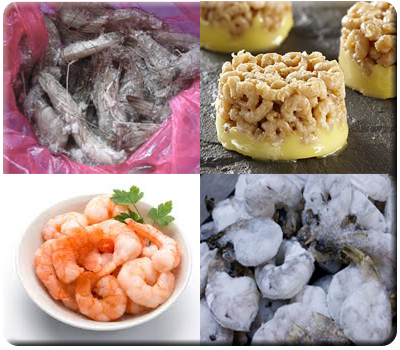Post Harvest Technology :: Seafoods - Crab
Preservation and Storage Process of Prawns::
Handling prawns:
The catch is first sorted or culled; other fish, dead or damaged prawns and rubbish are removed by hand or by sieve, and remove any remaining mud or sand, to reduce bacterial contamination. The prawns are drained as much as possible.
Freezing:
Prawns can be frozen by a solution of sugar and salt, by air blast freezing or by plate. Freezing in sugar and salt solution is claimed to give an improved glaze on the prawns, and to make separation of the prawns easier when thawing. |
Thawing:
Blocks of whole prawns frozen at sea or on shore can be thawed in air or water. The water spray method is the fastest because the fine jets help to break up the block as individual prawns thaw on the surface, thus exposing a greater surface area.
Individually frozen prawns can be thawed in a few minutes.
Size Grading:
Whole raw prawns are first graded by size, since large prawns are generally more valuable than small ones. Small prawns that are uneconomic to peel are either discarded or are used in chopped form as raw material for various products.
Cooking:
Cooking immediately after capture helps to retain the best flavour and colour.
Peeling:
Thawing prawns are easy to peel.
Chilling or Cooling:
Food poisoning bacteria can grow rapidly on the product if it becomes contaminated after cooking. So prawns are cooled. |
 |
 |
Cold Storage:
Frozen cooked prawns should be stored at -30°C, they will keep in good condition at this temperature, provided they are properly wrapped or glazed, for at least 6 months.
Canning:
This method used to preserve upto 6 to 1 year, prawns filled in cans and stored for long time, this technique not that much level used in worldwide.
Smoked Prawns:
Cold smoked products can be made from shrimp. Whole headless shrimp, or peeled meats, are boiled in a 10 per cent salt solution for about 3 minutes, drained for about 2 hours, laid on oiled mesh trays and smoked in a mechanical kiln for 1-1½ hours at 30°C.
Potted prawns:
Cooked peeled meats are heated in melted butter or added spices, and then ladled into containers, typically waxed cartons; the mixture is left until the butter has set, lids are put on and the cartons are wrapped in greaseproof paper and packed in outer cartons for dispatch. The product is highly perishable and should be sold within 1-2 days of manufacture. |
Other Prawns Products:
Prawn meats can be used in the preparation of a number of seafood products, including pastes, spreads, crisps, soups, bisques, sauces and other prepared dishes, most of which can be stored for long periods after freezing or canning.
Prawn waste:
Prawns waste, that is heads and shells, can be used to produce a prawn meal containing 40-45 per cent crude protein. Chitin and its derivative chitosan have also been extracted from prawn. Glucosamine hydrochloride, which can be derived from shell waste, has been suggested as a possible commercial source of glucosamine. And also sometimes cooked and dried on the Continent and used for feeding poultry and farmed trout. |
Source :
http://www.fao.org/fishery/culturedspecies/Penaeus_monodon/en
http://www.fao.org/docrep/field/003/ab915e/ab915e00.htm |
|


